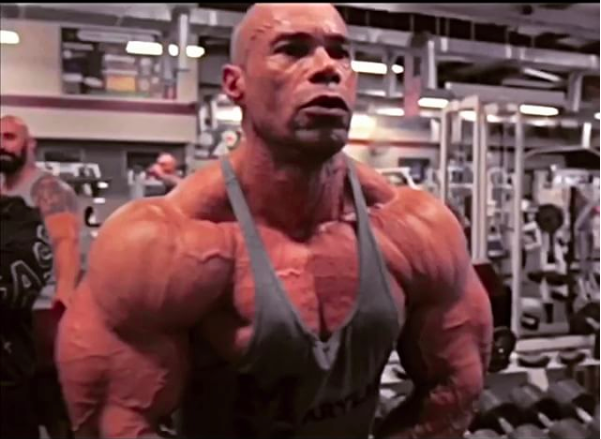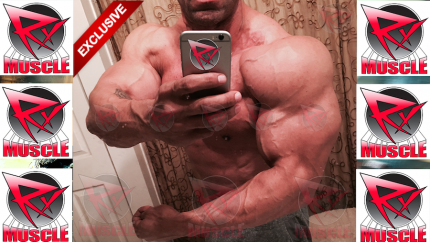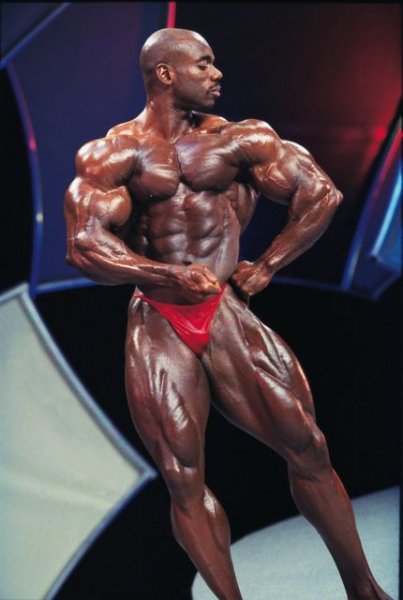The Return of Kevin Levrone

THE RETURN OF KEVIN LEVRONE
Triumphant Comeback? Or Potential Embarrassment?
By Bill Dobbins
The outstanding story of the 2016 Mr. Olympia is very much the return to competition of Kevin Levrone in his fifties after not appearing onstage since 2003. The bodybuilding world is discussing and debating whether Kevin can be competitive standing onstage next to amazing competitors such as Phil Heath, Kai Greene, Dennis Wolfe, and Dexter Jackson.
The fact that Kevin deserves to be taken seriously is evident by this entry in his Wikipedia page:
During his professional career Kevin competed in 67 IFBB professional contests. He has won 23 pro shows, holding the record of the most wins as an IFBB professional until Ronnie Coleman set the new record in 2004.
Kevin has always placed in the top six at the Olympia and was four times second. He has exhibited both incredible muscularity and outstanding symmetry. Not only that but his posing routines have always been highly aesthetic and artistic. In this era in which many are decrying the huge size and thickness of the top pro bodybuilders, the aesthetic quality of his physique is what many wish could become the standard judges used to crown the top champions in the sport.

Image courtesy of Instagram
But look at the obstacles Kevin Levrone is going to be facing. At 5'11" he weighed around 240 pounds at his best. Phil Heath, five times Mr. Olympia victor, is 5'9" and lists his contest weight at 250 pounds—and it’s hard to believe he weighs that little looking at him flexing onstage. He has 23-inch arms and a 29-inch waist. His thighs are 32 inches. Looking at Phil posing in his best shape, he almost looks as if he belongs to a different species!
Ironically, Phil Heath considers Kevin one of his all-time idols and role models.
“Kevin Levrone is one of my favourite bodybuilders,” Phil said in a YouTube interview. “When I first started looking at bodybuilding in a classroom in college in 2002 I happened to see one of his routines. Who is this guy? He looks like an athlete, all proportional … obviously I had Shawn Ray and Flex Wheeler to look at, but I started leaning toward Kevin.”
There has been a lot of discussion about Kevin’s age—52 years old in Vegas for the Olympia 2016. Actually, bodybuilding is almost unique in sport in that competitors who keep training and stay healthy can keep getting better right up until age 40 and beyond. Athletes in general tend to lose speed, endurance, and flexibility as they age—but can keep building muscle mass and strength for quite a long time. Think how much bigger a silverback gorilla looks compared to young males in his tribe. But it’s a fact that at a certain point the body ceases to respond as well to training and you begin to see a loss in muscle mass and density. People point to Dexter Jackson, who is 46 and shows no signs of diminished ability. But Dexter has kept up his training over the years, with no long layoffs, and keep in mind his Olympia win was a full eight years ago. So the comparison between Kevin and Dexter may not be that valid.

One thing to keep in mind is that bodybuilding is a true sport, although not everyone appreciates this. One factor that defines a sport is that it’s progressive—that is, athletes and athletic performance get better over time. This isn’t true of skills and games. The level of tennis or golf improves over time, but darts and billiards don’t. If you look back over the history of bodybuilding, from John Grimek to Bill Pearl, Larry Scott, Arnold, and Sergio to Lee Haney, Ronnie Coleman, and Phil Heath, the degree to which bodybuilding and bodybuilders have progressed is evident.
Can Kevin recover lost muscle and make the gains in so short a period that will allow him to keep pace with the evolution of the sport? Remember, despite his second-place finishes, he never won the Mr. Olympia title even in his prime

Image courtesy of Instagram
But he does have some things working in his favour.
Kevin Levone has had injuries in the past, but is apparently now healthy. His style has always involved training very heavy, which certainly helps to build and maintain dense muscles. But it also puts a lot of dangerous stress on the body. Just ask Ronnie Coleman, who is suffering a lot of disabilities due to years of heavy lifting. Bodybuilders with the longest careers such as Vince Taylor and Robby Robinson started doing much lighter workouts when they hit age 40.
Of course, since heavy training over time tends to wear out the bodies of all elite athletes, Kevin’s long layoff and past training style could actually work to his advantage. For example, he has been on record as having only trained hard for four months during much of his competitive career. This was obviously enough to allow him to amass one of the best competitive records in the history of pro bodybuilding. But training this way has also resulted in less wear and tear on his muscles, joints, tendons, and ligaments than would be likely if he had worked out hard all year long.
Kevin is so liked and admired it’s difficult to find bodybuilders who will go on record criticizing him or expressing doubts as to how well he will do at the Olympia. But one longtime pro said, “I expect Kevin’s upper body to be fantastic and highly competitive in the Mr. Olympia lineup. It is his legs I am concerned with. In my view it would take a lot longer to restore and build his lower body than he has in the time left before the competition.”
One bodybuilder who is not reluctant to go on record is Shawn Ray, who is another competitor who has been praised for many of the same reasons as Kevin Levrone, having a beautiful, aesthetic, and balanced physique along with outstanding posing and presentation. Shawn has also been known for being outspoken, and he doesn’t mince words talking about Kevin’s chances at the 2016 Mr. Olympia.

“I have very strong opinions about what he is trying to do,” Shawn says in a YouTube interview with almost 300,000 views. “I think it’s a foolish mistake. I think he is underestimating the talent that is there—even though it’s not the same hall-of-fame talent he once competed against. Kevin beat every bodybuilder he competed against except Dorian Yates. I think at his last Mr. Olympia he was sixth place—and he started out as first runner-up. He went out with an injury, and that injury was because of bodybuilding. So I would tell Kevin, you’re coming back to what—for what? You’re an entrepreneur, a father, and an icon in the sport. If you want to come back, come back with an exhibition tour.”
Shawn believes that Kevin would be a likely winner if he were to compete at a Masters Mr. Olympia, against other older bodybuilders. But even in that case, what would be the point? What risk compared to what benefit? Shawn Ray is aware that carrying a lot of extra weight when you are 52, taking the unpronounceable substances you find in the sport today, and lifting such very heavy poundages can be very dangerous. It doesn’t take much to tear a muscle or do other damage to the body. Look at the current condition of Ronnie Coleman and you can see how bad the results can be.
Shawn doesn’t think Kevin can even make the top six. And he can imagine what Kevin will feel like if he’s not in the first few callouts. “Not getting called out can make it a very lonely place out there. I know, I’ve been there.”

Flex Wheeler points out that Kevin’s comeback has breathed new life into the Olympia, creating a level of interest that has been lacking the past few years. “If Kevin comes in at only 90 percent of his best, he is going to do some damage and hurt some guys’ chances. Now, if he comes in at 80 percent he’s going to get handled by everybody. Probably within 30 seconds of his walking onstage it is going to be obvious what his placing will be.”
As for the danger of injury to Kevin with this comeback, Flex isn’t particularly worried. Not like Shawn Ray is. His view is that the modern techniques of training, compared to when he and Shawn were onstage, involve intense training but for much shorter periods and then more time taken to rest and recuperate. You don’t, he says, “have to bang every day.” This puts less stress on the body, and more recuperation lessens the chance of injury.
However, Flex realizes that all serious bodybuilding training is dangerous for all bodybuilders who do it. The sport itself is dangerous, no matter your age. In fact, all elite athletes put themselves in danger when they push their bodies to the extreme or an extended period of time. Elite competitive sport, he believes, is simply not healthy for anyone.
By the way, when it comes to size, Flex doesn’t really think today’s competitors have become anything like “too big.” True, there are some really massive bodybuilders on the scene, but they’re not generally the ones who are likely to place in the top three or even top six. Flex feels that he and Kevin and Ronnie Coleman represented a combination of a lot of mass plus great symmetry, proportion, and aesthetics. So Flex doesn’t think the alarm so many feel about the “direction” of bodybuilding nowadays is justified.

One thing Kevin Levrone has going for him is how much more quickly his body seems to respond to training and diet than most. For example, I recall seeing him onstage in the first of several Grand Prix events back in the 1990s where he wasn’t sharp and didn’t do that well. The next contest was the following week and Kevin showed up in perfect condition, sharp and defined, and won the contest. I don’t recall ever seeing anyone change and improve that much in such a short time. This is perhaps why he was able to do so well in competition although he was training seriously only four months a year. And this means that looking at Kevin eight months out or four months out might not give you a good idea of what he will look like come September 16 in Las Vegas.
Kevin can change so much and so quickly that we’ll have to wait until prejudging to know how good he looks.
So the consensus seems to be that the odds are against Kevin Levrone placing high in the Olympia and almost zero when it comes to beating Phil Heath. At the same time, if anybody has a chance for a major comeback at age 52, it’s probably Kevin, who is not only an all-time great bodybuilder, super-strong, and able to pack on a lot of mass but also somebody who has shown himself to be able to change his body faster than almost anyone else and has always been known both for having a symmetrical, aesthetic body and for being a great poser.
However, while there have been examples of elite athletes who excelled into their forties, and even made surprising comebacks, you don’t see this happening after age 50. Gordie Howe had a hockey career that lasted four decades. George Foreman restarted his boxing career in his forties with surprising results. Nolan Ryan continued to dominate from the mound as one of the best pictures ever in baseball—until his arm simply gave out at age 46 after 27 years in the majors.
Few boxing fans will forget the spectacle of Muhammad Ali’s last fight, standing almost helpless in front of Larry Holmes, who seemed reluctant to finish off his once-great idol. One example of an athlete over 50 doing surprisingly well in sports is when golfer Tom Watson made it all the way to a four-way playoff before losing the 2009 British Open at the age of 59. But although golfers are athletes, the technical skill component of their performance is more significant than it is in many sports.
I’m sure there are other examples in history of athletic success over 50 but this is no doubt a very, very rare occurrence. And it has never happened where elite pro bodybuilding is concerned. Aging is inevitable and the body declines with advanced age—sometimes very slowly but always inevitably. This is simply a fact of nature.
In any event, I think the major significance of Kevin Levrone’s comeback is primarily the interest it’s generating. This new level of excitement points out how little excitement there has been concerning the Mr. Olympia the past few years. This is the world professional championship of the international sport of bodybuilding, with fans all over the world, and yet there hasn’t been the kind of interest that you see in other sports such as football, soccer, or baseball. There are no “bodybuilding hooligans” roaming the streets and causing havoc. Fans don’t crowd in bars and restaurants for parties to watch the Mr. Olympia on TV. In fact, as far as the general public is concerned, they don’t know or care who wins the title.
It’s been many years since Ronnie Coleman was booked to appear on The Tonight Show after his Mr. Olympia victory. Interest from magazines such as Sports Illustrated is only apparent when some kind of major scandal is involved. Or seems to be. Otherwise, try to find a magazine article or news program about bodybuilding in which the topic of steroids isn’t emphasized.
As a matter of fact, there’s very little positive outside publicity for the sport at all because, to my knowledge, the IFBB pro division has no professional public relations representative—nobody selling the sport to mainstream magazines or television talk and interview programs. I can’t think of another major pro sport about which that is true.
So Kevin Levrone coming back to the Mr. Olympia is a real shot in the arm for pro bodybuilding, whether he does great, okay, or not so well at all. People are talking about the 2016 Olympia. They are debating. Shaw Ray says one thing, Flex Wheeler another. There is controversy.
Controversy generates interest and sells tickets. That’s a good thing for bodybuilders, fans, and everyone else involved. So thanks, Kevin. Your fans and admirers are all wishing you the best of good fortune.

